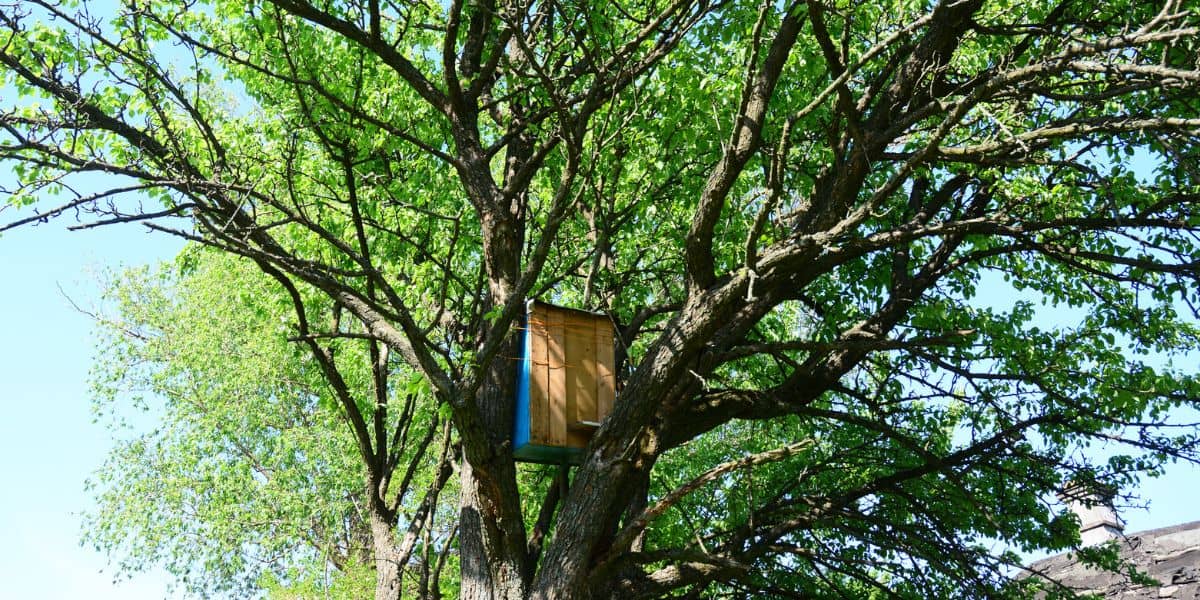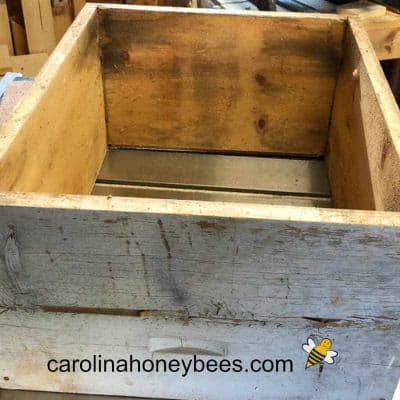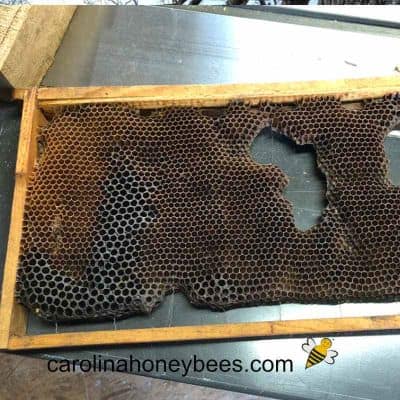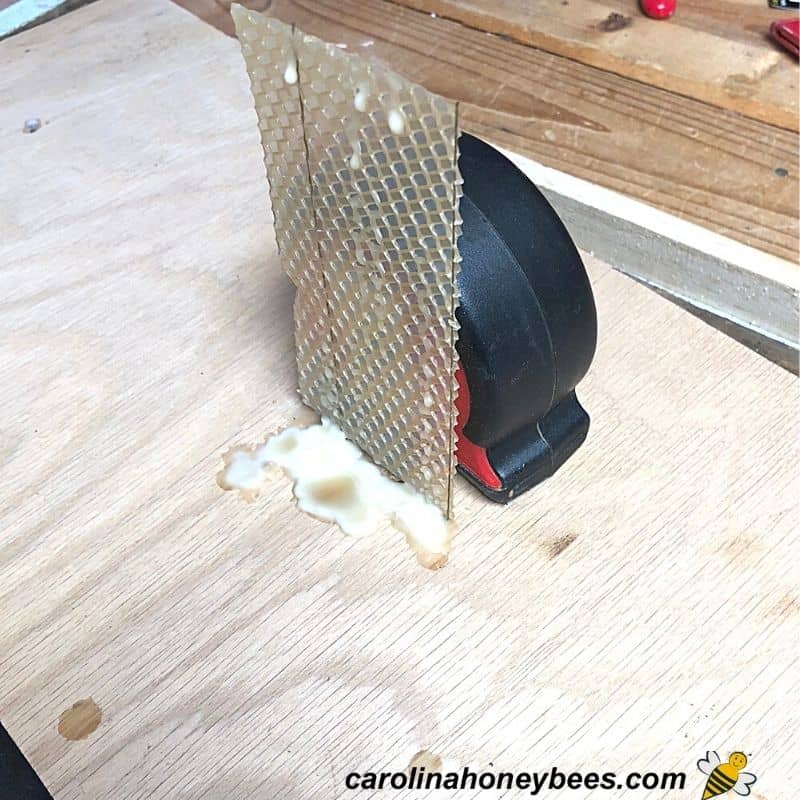Swarm Trap Setup
One fun way to get free honey bees is to set up honey bee swarm traps. Swarm traps refer to a variety of different structures that beekeepers use catch bee swarms. The beauty of this method is that once the task of setting up your swarm trap is finished – you can don’t even have to be there for it to work.

As a Master Beekeeper, I have spent may years putting up swarm traps. Personally, I think it is one of the most exciting aspects of beekeeping. While honey bee swarming is not always desirable in your apiary, this is one way to recoup some loses.
Honey Bee Swarm Traps
Buying honey bees and equipment can get rather expensive. If your budget does not allow the purchase of bees, a free swarm is a blessing.
Most beekeepers try their hand at catching bees at some time in their beekeeping experience. If you trap a swarm that issues from your own hive – that’s great. You prevented them from getting away.
What is a Honey Bee Swarm Trap?
Let’s get some beekeeping terminology out of the way first. The words : swarm trap, bee trap, and bait hive all mean the same thing. There are so many different types of honey bee traps, I could never list them all.
They can be made from many different materials or you can purchase commercial versions from beekeeping suppliers.
Buckets, wooden boxes, old hive bodies, nuc boxes and more have all be used to successfully trap honey bees.

When to Set Up Your Swarm Trap
Set up your swarm traps in late Winter – very early Spring. Swarming is a seasonal event that occurs most often in Spring. We want to get those traps set up well before the time arrives.
As colony populations begin to grow, scout bees will begin to search out new homes. This can take place sooner in the season that you may believe.
Late February works well for me but mid February into early March is good too. If you hear of other beekeepers in areas close to you seeing swarms, it is past time to get your swarm trap set up in a good spot. It will take a while for the scout bees to find your trap so get it out there.
Of course, you can set up a swarm trap any time during the warm season. You never know when a swarm may move in. Some honey bees swarm even into the Fall season.
But those early season swarms are very valuable because they have months to build up and prepare for Winter. They will be able to make use of the honey flow – or abundant nectar of late Spring.
Best Location
Much research has been completed on the ideal placement of bee swarm traps. You will find a wealth of ideas to help you choose a perfect spot.
Of course, remember – our bees don’t read the same beekeeping books that we do. I have seen many swarms ignore all of these good suggestions:
- elevate the trap off the ground 6-13 feet minimum
- face entrance towards southeast if possible
- have a small entrance 1″
- ideal space inside equivalent to a hive body or deep box
Most resources advise setting them up higher (around 13 feet or more) off the ground. However, that is too high for me to get down by myself! Do what works for you!
Choose a shady location as that is what bees seem to prefer. Also, you want the opening to the trap to be small – no more and 1-1 1/2″ in diameter.

Give your trap a solid bottom so the bees feel safe. You also need nice lids that are secure but easy to remove-perhaps use screws instead of nails.
I have caught small swarms in large boxes and had huge swarms move into tiny boxes. The problem here of course is that if the box is too small, the bees may move in and right back out the next day.
Having said all that, do not hesitate to set up a honey bee trap because you don’t have the perfect location or perfect materials. You just never know what can happen – sometimes they sit down on another hive in the apiary!

Honey Bee Trap Setup- Quick Guide
- Place your trap out 3-4 weeks before the Spring Nectar Flow
- Use a large container/old hive body with solid floor and top
- Drill a 1″ opening for an entrance
- An old piece of honeycomb inside attracts scout bees
- Use a commercial swarm lure if desired
- Check your traps often
- When bees moves in – move the bee colony to a permanent location
Make Your Own
A common type of bee swarm trap is made using an old hive body. Preferably, a scuffed old box with traces of comb, propolis (bee glue) and wonderful bee colony smells.
If you have been keeping bees for a few years, you probably have one of these laying around.
If not, ask around and you should be able to find an experienced beekeeper who would give you an old used hive body or sell it really cheap.
You may choose a more “earthy” type of trap made of wood pulp. Or some beekeepers prefer to use a small nuc box or plastic/cardboard one.
Nucs made of wood last for years. But, special cardboard nucs are great to have as well. They can be a bit flimsy but some duck tape firms them up good.

Swarm Lures or Bait
Before a swarm can move into your trap, they have to find it. Luckily bees have an extraordinary sense of smell. They are attracted to the bee pheromones left behind by previous bees, or those in honeycomb.
There are many techniques used for attracting bee swarms and the best types of lures to use. Part of it is making the bees feel at home.
If you have it , throw a piece of old comb in the bait hive. Yes, wax moth larvae may destroy the comb but that’s okay – it does not represent a significant loss.
And of course, you can purchase commercial swarm lure. I find that their quality varies greatly. One of my favorites is Swarm Commander. These lures last for several months.

Frames in a Swarm Trap
Some beekeepers choose to fill the swarm trap with the correct number of frames. A 10 frame box would get 10 frames – at least 1 with old comb (or a lure).
I have found that sometimes my traps are more successful if I leave more open space. In these cases, I place a frame or two of old rotated out comb in the hive and gently nail it to one side. This is so the frames do not move around when I take the trap down.

When I do this it seems that the bees tend to ignore the frame and attach comb from the top/inner cover. That’s okay, I don’t leave them there long.
I use an old piece of homemade beeswax candle to attach a small strip of foundation to the underside of the inner cover.
Most of the time, the bees will choose that spot to begin building comb. I like this as it ensures that the comb is in the middle of the box and less likely to be attached to sides.
If you choose this strategy, it is even more important to check the trap weekly. We do not want the swarm to waste a lot of on comb construction in that empty space – and they will!
We hope to encourage the bees to build comb – where they need it later.
You can not leave them in there very long or you will have a mess in that open space. I used to put a box full of frames in the boxes but I catch more swarms without them.

Getting the Bees Down !
A bait hive can get very heavy in a hurry. When you are choosing a place for it, think about how you are going to get it down with bees and some honey inside.
I have this box connected to a rope that allows me to raise and lower it with ease. The use of a pulley system is a great idea. Don’t under-estimate how quickly a swarm trap can become too heavy to handle.
It is rare to get out to this box without being accompanied by some of the farm animals- goats, donkeys or barn cats. Who would have guessed that they knew so much about setting up a swarm trap ?!

How Many Traps Should You Have?
How many swarm traps you need depends on your space, time and budget. Only have as many traps as you can check often – ideally weekly.
Most are only designed to hold the swarm for a brief time. The new colony will outgrow it quickly. It is good to have several swarm traps spaced out in different locations or directions from where you have set up your bee yard. We never know for sure which one the bees will like best.
It Does Not Always Work
There are several possible reasons for a trap’s lack of success. Perhaps there were fewer swarms in the area that year. Or maybe the bees found better accommodations elsewhere.
Or just maybe, there was something about that trap that the early visiting scout bees just didn’t like. Next season try another trap of a different size or material – maybe change the location a bit too.
Also, honey bee swarms don’t always choose to go into provided boxes. Often, a beekeeper will need to catch the bee swarm out of a tree.
FAQs
Yes, honey bee swarm traps do work and are very successful at catching bees. However, no bait hive will catch every swarm of bees. You may have to experiment with location, box size and lure.
The safest option is to put 1 frame of old comb and 3-4 frames with new foundation in a swarm trap. Check it often and move bees to a complete hive right away.
The depth of a deep hive body seems to be the perfect size to entice most honey bee swarms.
Most beekeepers leave a swarm in the trap for about a week to let the bees settle in. But, this is personal preference and depends on the type of trap used and the schedule of the beekeeper.
A Final Word
At over $100 per bee family, learning to set up a swarm trap is not effort wasted. If you trap only 1 swarm in the season – your investment was worthwhile. And sometimes, you have even better luck. I think my record was 4 swarms in my favorite trap in one summer. Have some fun this season and experiment by setting up swarm traps in your neighborhood.

